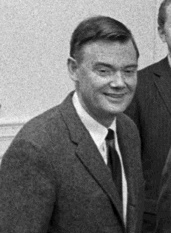
Harold Barefoot Sanders, Jr., was born in Dallas in 1925. Barefoot was his grandmotherís maiden name, Dennie Barefoot. Though he disliked the name as a youngster, he embraced it as an adult. He attended local schools, graduating from North Dallas High School in 1942. He enlisted in the navy the next year, serving on a battleship in the Pacific for the remainder of World War II.
When he returned in 1946, he enrolled at the University of Texas. He was a popular figure on campus and worked hard at his studies, graduating in 1949. He quickly enrolled at the UT Law School and earned a law degree by the next year. He found a position at a Dallas law firm and looked to a future in politics.
In 1952, he was elected to the Texas House of Representatives, his first of three terms. He sponsored a number of reforms to investment law, the judicial process, and to the stateís mental health care system. In 1958, he ran for Congress for the Dallas County district held by Republican Bruce Alger but lost decisively.
In spite of the defeat, John F. Kennedy hired Sanders to manage his presidential campaign in Dallas County in 1960. Afterward, Kennedy appointed Sanders as US Attorney for the District of North Texas. In that fateful November in 1963, he warned Kennedy not to come to Dallas for his goodwill tour of the state, fearful of the toxic political atmosphere of the time. Sanders rode in one of the cars in the motorcade that included Vice-President Lyndon Johnson and Gov. John Connally. After the presidentís murder in the streets of Dallas, he located and brought federal judge Sarah T. Hughes to Love Field to swear in Johnson as president.
Sanders became the Assistant Attorney General in 1965 and helped convince Congress to pass the landmark Voting Rights Act, which allowed millions more American citizens be able to vote. He also served as legislative counsel, helping the president with legal aspects of legislation and helping pass his agenda. Johnson nominated Sanders for a position as federal judge in 1968. However, legislative delays prevented the Senate from acting upon the nomination before Johnsonís term in office expired. The incoming president, Richard Nixon, refused to nominate Sanders.
Sanders returned to private law practice, and in 1972, he announced his candidacy for the US Senate. He faced former US Sen. Ralph Yarborough in the primary, who was ousted in the 1970 primary by Lloyd Bentsen. Sanders won the Democratic nomination but lost to Tower that fall by a sizable margin that fall.
In 1979, President Jimmy Carter nominated Sanders to be a federal judge for the Federal District Court for the Northern District of Texas. Sanders was confirmed easily. As a federal judge, he oversaw many cases, but the most prominent was the desegregation of Dallas schools.
Dallas, like many cities across the country, faced racial divisions for decades. Many Dallas leaders tried to downplay the severity of those problems or denied they even existed. The Dallas school board had slowly moved to desegregate the schools in the late 1960s, a handful of students at a time. Even this enraged segregationists who refused to accept any desegregation of schools and civil rights activists who believed the rights of all Dallas school children were at stake.
After years of court fights, the case landed in Sandersís court. By 1981, he ordered a new desegregation plan for Dallas, which he would oversee the implementation for the next twenty years. The legal system works on past precedents. For Sanders, the law was not about protecting the status quo or even a privileged few. The law and the rights promised to all Americans in the Constitution had to apply to everyone for it to mean anything. Though the changes were sometimes difficult, Dallas slowly moved toward desegregation of its schools.
Sanders stepped down from an active role on the court in 1996. Once he took senior status, as it is called, he took only the occasional case. As his health declined in his later years, he retired completely from the court in 2006. He died in 2008 at the age of 83.

